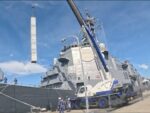Defense tech startup Anduril has unveiled a surface-launched variant of its Barracuda drone, repurposing the air-launched loitering munition with a custom booster kit. This adaptation aims to enable mass production and scalable deployment of precision fires from ground-based platforms—an approach aligned with emerging U.S. Army and joint force concepts for attritable autonomous strike systems.
Barracuda’s Origins as an Air-Launched Loitering Munition
The Barracuda was originally developed by Anduril as an air-launched loitering munition (AL-LM), designed to be deployed from tactical aircraft such as the F-16 or larger drones like MQ-9 Reapers. The system is part of the U.S. Air Force’s Collaborative Combat Aircraft (CCA) and broader Advanced Battle Management System (ABMS) initiatives focused on fielding autonomous systems that can operate in contested airspace.
Weighing approximately 45 kg and featuring pop-out wings, Barracuda is designed for high subsonic flight and extended loiter times. It carries an EO/IR sensor suite for target acquisition and terminal guidance. The drone is capable of executing both reconnaissance and kinetic strike missions against mobile or fixed targets.
Its modular design allows it to be integrated into various launch platforms via standard MIL-STD interfaces. Prior to this development, it had been tested in captive-carry configurations under fighter aircraft pylons and launched during live-fire tests at ranges such as Eglin AFB.
Surface Launch Conversion via Booster Kit
The new development involves retrofitting the Barracuda with a solid-fuel booster motor attached beneath its fuselage. This booster enables vertical or angled launch from ground-based canisters or vehicle-mounted rails—similar in concept to how Israel’s Harop or AeroVironment’s Switchblade are deployed.
According to Anduril representatives at recent demonstrations (including Project Convergence events), the conversion requires minimal modification to the core airframe. The booster separates after burnout, allowing the drone’s electric or small turbine propulsion system to take over during cruise and terminal phases.
This adaptation dramatically expands deployment options—enabling use by artillery units, forward operating bases, or even distributed launch cells in denied environments without reliance on air assets.
Enabling Massed Precision Fires at Scale
The shift toward surface-launchable drones aligns with evolving U.S. Army concepts such as “Fires Future” and “Manned-Unmanned Teaming” (MUM-T). These frameworks emphasize scalable precision effects delivered by low-cost attritable systems that can saturate enemy defenses or prosecute time-sensitive targets without risking high-value platforms.
- Cost-efficiency: Ground-launched drones reduce logistical complexity compared to manned sorties.
- Scalability: Dozens can be launched simultaneously from dispersed locations using automated fire control networks.
- C4ISR integration: When networked via Link-16 or proprietary mesh protocols like Lattice OS (developed by Anduril), these drones can receive real-time targeting updates from ISR assets or battlefield sensors.
- Saturation tactics: By launching swarms of loitering munitions simultaneously, defenders’ SHORAD systems may become overwhelmed due to sensor saturation or missile depletion.
Tactical Implications Across Domains
The ability to repurpose AL-LMs like Barracuda into ground-launched variants introduces flexibility across multiple operational domains:
- Land Warfare: Artillery units gain deep-strike capability without relying on GPS-guided shells vulnerable to spoofing/jamming.
- A2/AD Penetration: Surface-launched UCAVs can be prepositioned near frontlines or littoral zones for rapid response against mobile threats like SAM batteries or naval vessels.
- Expeditionary Ops: Marines or SOF teams could deploy containerized launchers in austere environments where air support is delayed or denied.
- Navy Integration: Shipboard VLS-adaptable versions could provide organic strike options beyond traditional missiles at lower cost-per-shot ratios.
Status of Testing and Future Procurement Outlook
The surface-launchable Barracuda has reportedly undergone successful static test firings using prototype booster kits at undisclosed U.S. test ranges in mid-2025. Live-fire demonstrations involving coordinated launches from multiple mobile launchers are expected later this year under Project Convergence and EDGE events led by Army Futures Command (AFC).
No formal procurement contract has been announced yet; however, Anduril has submitted proposals under the U.S. Army’s Long Range Precision Fires Cross Functional Team (LRPF-CFT) initiatives as well as SOCOM’s Tactical Offensive Support program lines. The system may also compete within the U.S. Navy’s SCIFIRE initiative seeking low-cost hypersonic alternatives through attritable platforms.
Industry Context: Attritable Systems Race Intensifies
This move places Anduril squarely in competition with other vendors pursuing similar capabilities—such as Kratos’ XQ-58 Valkyrie (larger class), General Atomics’ Eaglet AL-LM variant, AeroVironment’s Switchblade family, and Israel Aerospace Industries’ Mini Harpy line—all vying for roles in multi-domain kill webs emphasizing autonomy and affordability over exquisite performance alone.
If successful at scale-up production levels—which Anduril claims it can achieve rapidly due to vertical integration—the surface-launched Barracuda could become a key component of future kill chains across Indo-Pacific scenarios where distributed operations are vital due to range/sensor constraints imposed by Chinese A2/AD bubbles around Taiwan and South China Sea regions.









